| Srl | Item |
| 1 |
ID:
131594
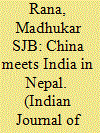

|
|
|
|
|
| Publication |
2013.
|
| Summary/Abstract |
This article attempts to conduct a comprehensive assessment of India and China's interests in Nepal in the wake of the drastic political Nepal since 2006. In this regard, the '6C- Frame of 1 as been employed in the context of Nepal, viz, 1) What are : interests of China and India?; it) What are their conflicting I) What are the areas of cooperation," (iv) What are the areas ' v) How do they diplomatically communicate their T vi) How do they diplomatically coordinate their interests cooperation and minimize con?ict?
|
|
|
|
|
|
|
|
|
|
|
|
|
|
|
|
| 2 |
ID:
131596
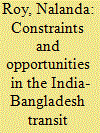

|
|
|
|
|
| Publication |
2013.
|
| Summary/Abstract |
This research note explores the transit issue that has become one of the most problematic disputes overtime between India and Bangladesh. It also analyzes its long-term implication in the bilateral relations between them. The history dates back to the pre independence period when Bangladesh and India were part of the British colony. The roads_. water and railways were then integrated in the communication system. The outlets to the sea were through Chittagong port or via the rivers of Bangladesh reaching the ports of Kolkata. India had pressed Bangladesh to provide transit facilities through the hearts of Bangladesh to connect West Bengal in the west and Tripura in the east. India claims that it will use this transit facility solely for the transport of ?eight and goods between two remotely connected parts of India. But Bangladesh has persistently denied any such agreement earing it as a threat to national security.
|
|
|
|
|
|
|
|
|
|
|
|
|
|
|
|
| 3 |
ID:
131597
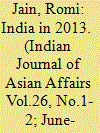

|
|
|
|
|
| Publication |
2013.
|
| Summary/Abstract |
The year 2013 witnessed momentous developments in the outside world which impinged on India's national interest in several ways. The UPA, leading the central government, is struggling hard to review the national
priorities at the fag end of its second term. Addressing the fifth annual conclave of Indian mission heads in New Delhi in November 2013, Prime Minister Manmohan Singh stated that the UPA government had sought to bring about a "fundamental reset" in lndia's foreign policy based on lndia's national priorities and its role and destiny in world affairs. He stipulated the following five de?ning principles of the country's foreign
policy.
|
|
|
|
|
|
|
|
|
|
|
|
|
|
|
|
| 4 |
ID:
131592
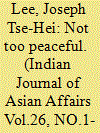

|
|
|
|
|
| Publication |
2013.
|
| Summary/Abstract |
Much attention has been paid to China's determination to exert its in?uence over the East and South China seas using both political and military power. The final ?ew weeks of 2013 saw a rapid deterioration of the diplomatic goodwill that China had built with its maritime neighbours over the past several decades, threatening regional stability and risking an arms race with the U.S., Japan, and Southeast Asia. This article draws on some snapshots of the latest sovereignty disputes in the East and South China seas and the bilateral ties across the Taiwan Strait to discuss the continuities and breakpoints in China "s strategic outreach in a multipolar world. It argues that the ability of China to pursue security interests in its maritime ?rontiers is largely contingent upon many circumstantial factors.
|
|
|
|
|
|
|
|
|
|
|
|
|
|
|
|
| 5 |
ID:
131593
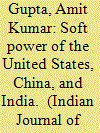

|
|
|
|
|
| Publication |
2013.
|
| Summary/Abstract |
As countries compete for dominance in International Politics, soft power has emerged as a major tool for nation states to ensure enhancement of their intangible standing, besides strengthening their in?uence in a benign way. The United States, China and India are considered prime examples in the ?eld of soft power, though the nature, intent, and fruition of soft power vary in each case. This article attempts to highlight and analyze the diverse nature of soft power that these countries possess, and illuminate as to how di?etently they have used their soft power resources. And ?nally an attempt has been made to put forward a case that each of these countries presents itself as an archetype-- they may learn from each other's successes and missteps in the domain of soft power.
|
|
|
|
|
|
|
|
|
|
|
|
|
|
|
|
| 6 |
ID:
131591
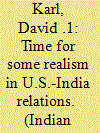

|
|
|
|
|
| Publication |
2013.
|
| Summary/Abstract |
Befitting two raucous democracies, once estranged but increasingly fraternal, the U.S.-India relationship routinely evokes grandiloquence about "natural allies," "an affair of the heart," "kindred spirits," "common DNA" and a defining partnership" shaping the destiny of the 21st century. Such sentiments were on full display in late 2009 when Prime Minister Manmohan Singh visited the White House as President Baraek Obama's first official state guest. In the run-up to the event, Obama declared that Mahatma Gandhi "was a real hero of mine" and let it be known that he considered Singh and India part of his family. The extravagant state dinner staged on the South Lawn was the hottest ticket in town, attracting party crashers to boot, and even the rainy weather did not dim an event the Washington Post likened to a Hollywood production. And with expectations raised by the recently-codified U.S.-India nuclear cooperation agreement, the two leaders spoke augustly about a "future that beckons all of us."'
|
|
|
|
|
|
|
|
|
|
|
|
|
|
|
|
| 7 |
ID:
131595


|
|
|
|
|
| Publication |
2013.
|
| Summary/Abstract |
This article attempts a diagnosis of the global governance crisis especially in the light of the global financial crisis, and critically solutions proposed by various experts and scholars. Finally, it offers the recommendations through a balanced approach that takes into consideration practical realities of the integrated economic world order. Its explore the alternative role of the BRICS countries (Brazil, the on, India, China, and South Africa) in global economic global governance
|
|
|
|
|
|
|
|
|
|
|
|
|
|
|
|